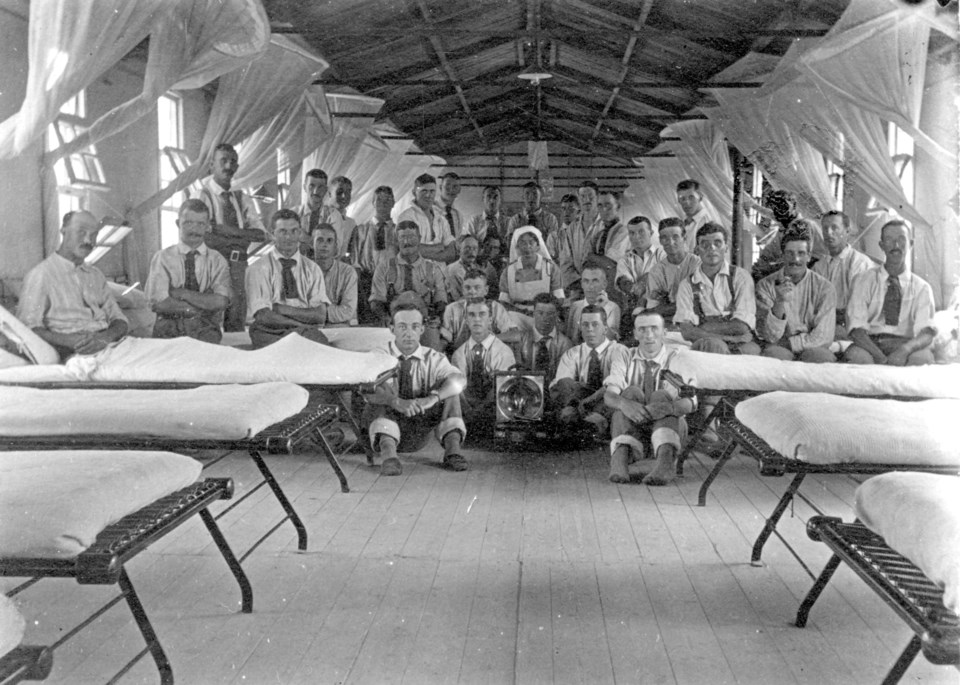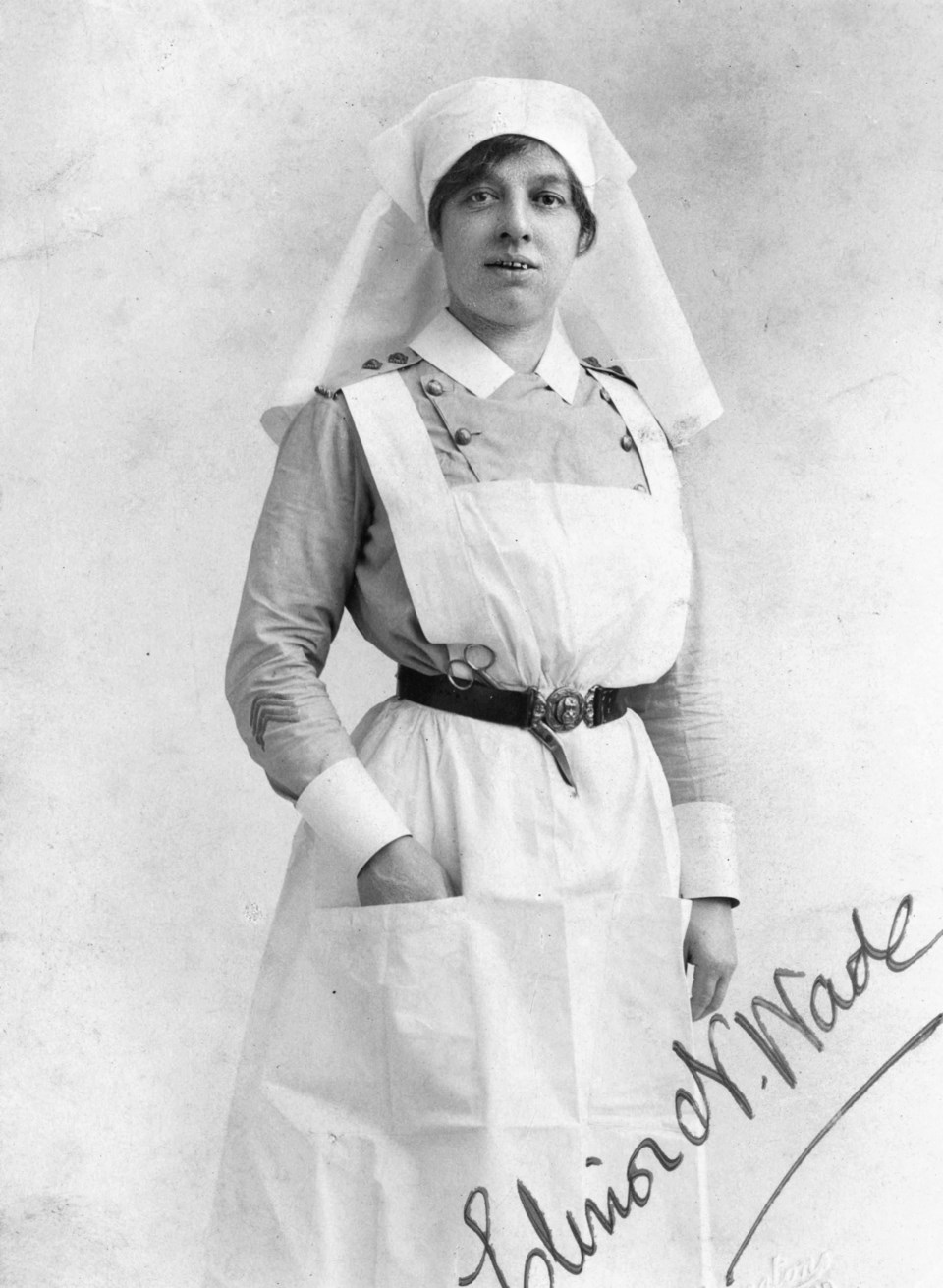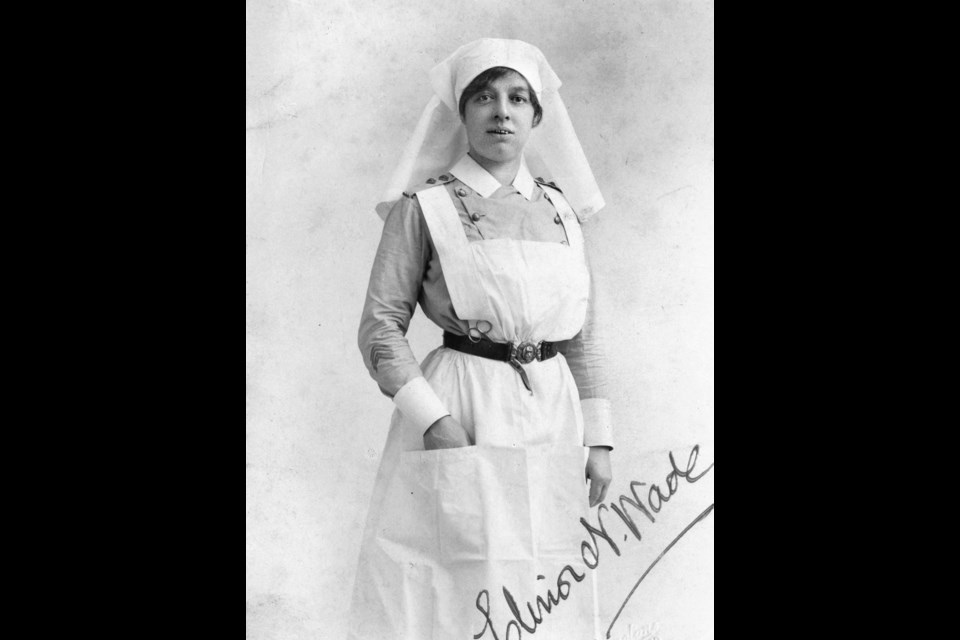March 1917, Le Treport, France. With snow blowing outside No. 5 Canadian General Hospital and heating coal in short supply, Nursing Sister Beatrice Kilbourne bundled up in her coat and “coarse brown blanket” and wrote in her diary about the night shift she’d just worked.
“Night duty on a surgical wing with 46 patients, all very sick and sore. Any one of them liable to hemorrhage any minute, treatments, etc. is no soft snap. The strain and anxiety is worse than any amount of work. We who thought we were hard worked at home knew not what work really was.”
Kilbourne, however, had no regrets. She went on: “But here there is always the feeling that first — it is only our duty we are doing — 2nd, it is a pleasure to be able to do it. The boys are so grateful and so good and patient.”
On March 23, she wrote: “Awfully tired. Watching 5 patients who are liable to ‘blow’ at any moment.”
On March 25: “Two deaths and a convoy [of wounded arrived]. Busy night.”
On March 27: “Poor old Grant had amputation. Awfully sick during night.”
By March 29, she was looking forward to the “24 hours sleep” that would come in five days’ time, and bemoaning the fact that her “husky” appearance meant she’d been assigned the night shift four weeks in a row.
But sleep wasn’t always easy. On March 31, she wrote, “Raining in torrents. Came through cracks in hut on my bed.” Even so, she added, “Poor boys up the line! How comfortable we are even here. How thankful we should be.”
Nurses on the frontline
Kilbourne was just one of the 3,141 Canadian women who served as nurses during the First World War. Some worked at hospitals in England, while others served in France, close enough to the trenches to hear the guns at night and see the flashes as artillery bombardments lit up the sky. Others wound up at Canadian military hospitals in such far-flung locations as Egypt or Greece.
Kilbourne’s diary entries begin with her departure, together with nine other nursing sisters, from England. The train station was filled with “hundreds of officers and thousands of troops, Nursing Sisters, V.A.D.’s [Voluntary Aid Detachment members] and a few anxious looking civilians no doubt on their way to see some son or brother or loved one who had been placed on the ‘Dangerously ill list’ — wondering if they would still be alive to greet them when they arrived.”
The nurses boarded a troop ship filled with soldiers returning from leave to the front lines. “A great number of them looked old, and weather beaten, and none too happy about their returning to ‘Hell’ as they expressed it.”
Those aboard were issued life belts and ordered to remain quiet. Submarines had been spotted in the English Channel, and British patrol boats were sweeping for mines. After a two-hour crossing, the troop ship docked at Boulogne.
“Here I was in France, on my way to do the work I had dreamed of doing for so long,” Kilbourne wrote on Feb. 20.
She was assigned to No. 2 Canadian General Hospital in Le Treport, where she was greeted by other nursing sisters who were “rushed to death.” There, she shared a room in a “dugout” with four other nurses.
Her first shift was on Feb. 23, nursing 46 patients. “I was posted to Wing 2, a big surgical wing for very bad cases having mostly Carrol [Carrel] tubes in wounds. Work very interesting.”
She was referring to the Carrel-Dakin treatment, invented during the war to solve the problem of deep wounds contaminated with mud. French surgeon Alexis Carrel created the mechanism to irrigate the wounds (it looked much like a modern intravenous drip), and English chemist Henry Dakin invented the sterilizing solution. The treatment dramatically reduced infection and thus the need for amputations.
Many of the casualties coming to the hospital had been hit by machine gun fire or shrapnel. “Very few have one hole,” Kilbourne wrote. “More often we find 6 [to] 40 in one boy.”
On the day Kilbourne arrived, the hospital had 1,138 patients, according to the official War Diary kept by its commanding officer. More arrived every couple of days by “convoy” from the front lines.
March 21 was a typical convoy. The War Diary for that day (available online at collectionscanada.gc.ca from Library and Archives Canada) notes that the ship arrived at 1 a.m., carrying 78 wounded and 130 sick.
The vast majority were “Imperials” (British), but there were also two Canadians and one New Zealander.
That March, a total of 1,630 patients were admitted; 178 were Canadian soldiers.
Kilbourne’s diary, preserved at the City of Vancouver Archives, ends in April 1917.
Another diary, that of Elinor Newton Wade, was written two years earlier and describes the excitement of enlisting as a nursing sister.
Wade joined up in 1915. After three weeks of drilling and lectures in Victoria, she began her journey to the front on Aug. 20. Bands played and “crowds of people” came out to send off the nursing sisters as they marched in their military uniforms from the drill hall to the boat. In Vancouver, similar crowds wished them well.
The train across Canada carried 70 nurses, two assistant matrons, one matron, 32 doctors, two quartermasters and 203 men of the Canadian Army Medical Corps, all with No. 5 Canadian General Hospital.
Also aboard were three sections of Field Ambulance.
“The O.C. [Commanding Officer], Col. Hart., is very strict,” Wade wrote. “We are not allowed to converse to doctors and officers, only answer if spoken to and of course, have no dealings what ever with the men.”
The train reached Montreal Aug. 26. There, they settled into a routine. “At dinner at night we wear full dress and do not sit down until O.C. does, or get up till he proposed King’s health and we all stand up. Roll call at 9 am. and parade inspection at 9:30 am.”
Wade’s account ends there, but a glimpse into life with No. 5 Canadian General Hospital can also be found in a scrapbook, also at the City of Vancouver Archives. It holds dozens of photos taken by Nursing Sister Emily Eliza Edwardes, who later married Major James Skitt Matthews, Vancouver’s first archivist.
Edwardes joined up in Victoria in July 1915. Her photos include snapshots of the nurses marching through the streets of Victoria that August; by December they’d reached Cairo, Egypt. Their final destination was Salonika (modern Thessaloniki) Greece; from December 1915 to August 1917 the hospital treated sick and wounded soldiers from the Salonika Forces who were fighting the “Bulgars” (Bulgarians) that had attacked Serbia.
The scrapbook includes pictures of military tents, soldiers picnicking with nurses, hospital ships — and Edwardes perched atop the remains of a German zeppelin that had tried to bomb Salonika’s harbour on May 6, 1916, only to be shot down by HMS Agamemnon.

Close call
According to Veterans Affairs Canada, of the 2,504 nursing sisters who served overseas, approximately 45 died. Some died of disease; others were killed when hospitals were bombed or hospital ships sunk.
Edwardes had a close call on Nov. 23, 1916. She was aboard the hospital ship Braemar Castle as it steamed from Salonika to Malta, evacuating British wounded. Edwardes, on leave, was sitting on deck reading a book “on a dull day with a gentle breeze and low waves.” Suddenly, around 11 a.m., an explosion tore through the ship.
She at first thought a submarine had torpedoed the ship — later, it turned out the ship had struck a mine. The explosion amidships — a “frightful bang” — sent those aboard scurrying for lifeboats and life rafts. With the wireless radio destroyed by the blast, the ship sounded her whistle, “a terrible prolonged noise” that eventually brought two minesweepers to the rescue.
“Five lives, all wounded soldiers, were lost; killed in their hospital cots on the ship; one more died in the small boats, and was subsequently buried with military honours on the island of Syra where we were landed,” Edwardes reminisced two decades later. “The coal bunkers had cushioned the explosion which did great damage... but did no hurt to the engines, and the ship did not sink, but the hospital patients looked like darkies they were so coated with coal dust.
“The Braemar Castle was still afloat when we last saw her in the distance, but the previous day a big British hospital ship, the Britannic was not so lucky; the same German submarine sank her.”
A month after the incident, on Dec. 10, 1916, Edwardes received a thank-you letter from James E.E. Walton, whose son, Tom Walton, a gunner with the Royal Field Artillery, had been aboard the Braemar Castle.
Walton’s father wrote: “We have not met you and may never do so but let us assure you will always occupy a foremost place in our minds and hearts, and if by any chance you may, after your labours of love and mercy are completed, you find yourself in good old England and you can find time to call at the above address you will be made welcome.”
Soldiers’ appreciation
The nurses’ diaries preserved at the City of Vancouver Archives include several pages written by grateful soldiers who were treated at Salonika. One of these was H.P. Sarjant, a signalman with the 6th Leinster Regiment Royal Canadians.
“I was sent up to the No. 5 Canadian Hospital with illness, and put in M.D. 2 ward, and thanks to splendid treatment by the Canadians I soon was myself again,” Sarjant wrote. “It was Captain Gibson who cured me, and I leave the hospital a grateful patient.”
William T. Darke of the Royal Fusiliers, 28th Division, wrote a poem in the diary on April 10, 1916, and concluded by adding, “With best wishes for the staff of the 5th Canadian Gen Hospital Salonika, whose careful treatment I’ll always remember.”
But the soldier who perhaps summed it up best was G.P. Davies, a sapper with the Royal Engineers S Service. On Feb. 20, 1916, he wrote, “This hospital is the finest thing that ever happened. The doctors I think could cure wooden legs. The sisters are ‘angels.’ The orderlies are ‘lads.’ They have sent poor old ‘Hobby’ away but Sargent and myself are after him. ‘There’s no rest for the wicked.’”




